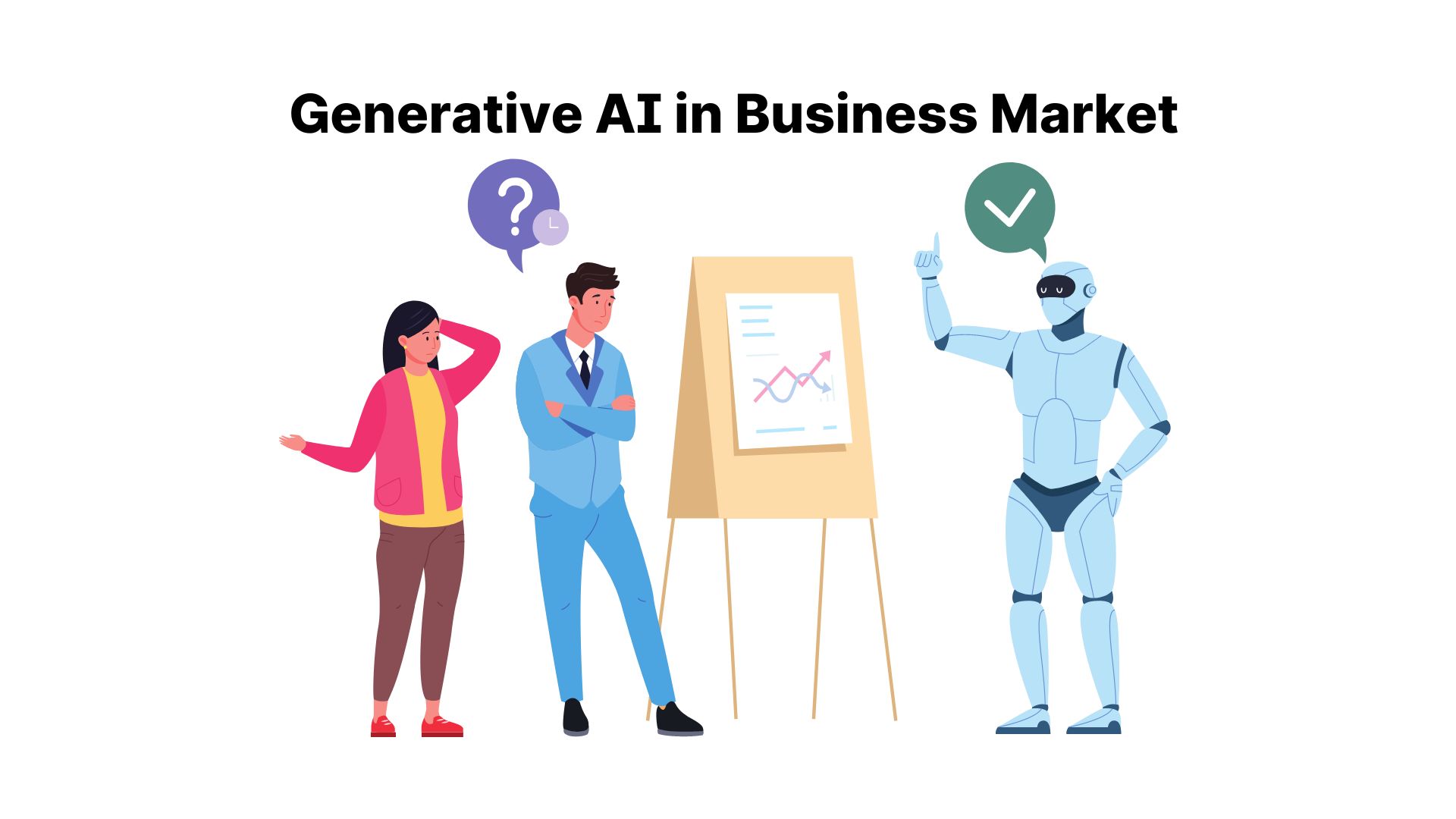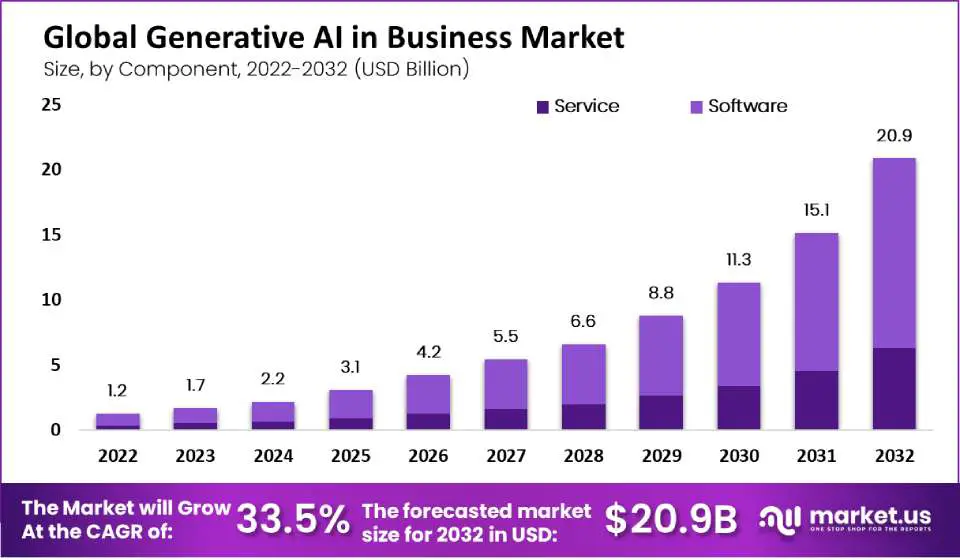Generative AI in Business Market Size is projected to grow at a CAGR of over 33.5%

Page Contents
Market Overview
Published Via 11Press : In 2022, the Global Generative AI in Business Market size was estimated to be USD 1.2 billion and it is projected to experience compound annual growth of 33.5% during its projected forecast period 2023-2032 – projected to reach USD 21.6 billion by 2032.
Generative AI, also referred to as creative AI, is a subset of artificial intelligence which uses algorithms to produce unique and original content from input data such as texts, images, and videos. Generative AI technology has seen explosive growth over the years among businesses of various industries looking for ways to automate and streamline operations with its help.
Healthcare institutions are using generative AI for drug discovery, personalized medicine, and imaging analysis; retail outlets utilize it for product design, marketing campaigns, and customer experience improvements; while in automotive industries generative AI helps develop autonomous vehicles and optimize design optimization processes.
The report highlights that North America is projected to lead the generative AI market throughout its forecast period due to its high adoption of advanced technologies. Europe and Asia-Pacific should experience significant growth due to their increasing adoption of AI across a range of industries.
Overall, the generative AI market is projected to experience continued rapid growth over the coming years, as more businesses adopt this technology to automate and streamline their operations. But as with any emerging technology, concerns have been expressed over potential misuse for malicious purposes by some individuals who could misuse this form of artificial intelligence technology.
For further details on major revenue-producing segments, request a pricing optimization software market Request for PDF sample report

Key Takeaways
- In 2022, the global Generative AI in Business Market size was valued at USD 1.2 billion and projected to experience a compound annual growth rate of 33.5% between 2023-2032 – ultimately reaching an expected value of USD 21.6 billion by 2032.
- Rising demand for generative AI from various industries such as healthcare, retail, and automotive is driving its market expansion.
- Generative AI is being utilized in applications spanning drug discovery, personalized medicine, medical imaging analysis, product design, marketing campaigns, customer experience optimization, autonomous vehicle development, design optimization, and more.
- North America is expected to lead the generative AI market over the forecast period due to the increased adoption of advanced technologies within this region, although Europe and Asia-Pacific should experience steady growth within their respective generative AI markets.
- However, the ethical repercussions of generative AI should be considered carefully in terms of potential misuse for malicious purposes.
Regional Snapshot
- North America: North America is projected to lead the generative AI market during the forecast period due to the high adoption of advanced technologies there and due to major solution providers like OpenAI, Nvidia, and IBM which contribute significantly to market expansion there.
- Europe: Europe's generative AI market is projected to experience substantial expansion due to growing adoption across industries like healthcare, retail, and automotive. Furthermore, European Union governments have made substantial investments in AI research and development projects which is fuelling this regional surge.
- Asia-Pacific: Asia-Pacific's generative AI market is expected to experience substantial expansion due to increased adoption across various industries like healthcare, retail, and automotive. China, Japan, and South Korea have made significant investments in AI research and development programs which is fuelling market expansion across this region.
- Rest of the World: The global generative AI market is projected to experience moderate growth during its forecast period due to lower adoption of advanced technologies in these regions; however, increasing AI usage across various industries should drive this sector as well.
Drivers
- Increasing demand for AI-powered automation: Businesses are turning more frequently to AI solutions like generative AI to automate and streamline their operations, including product design and customer service. Generative AI solutions can be utilized across many fields to save costs while increasing efficiency while improving customer experiences.
- Consumer demand for personalized content: Modern consumers expect tailored experiences, and AI can help businesses meet these demands by crafting unique and targeted pieces based on user data.
- Advances in deep learning algorithms: With more sophisticated deep learning algorithms on hand, generative AI solutions are now capable of producing more realistic and sophisticated content than ever before.
- Increased Access to Training Data: With more data readily available for training generative AI models, businesses are finding it easier and more accurate results from training them.
Restraints
- Ethical Concerns: Businesses and consumers alike have expressed major ethical concerns surrounding generative AI's potential misuse for malicious purposes such as creating fake news or deep fakes.
- Lack of transparency: Generational AI algorithms can be complex and challenging for businesses to interpret, making it challenging to grasp how they're making decisions and producing content.
- High costs: Implementing and developing generative AI solutions is costly, and not every business has the resources available to invest in this technology.
- Lack of Understanding AI: Some businesses may lack an accurate grasp of the capabilities and limitations of generative AI, leading to unrealistic expectations and disappointing results.
Opportunities
- Emerging Applications: Generative AI offers numerous promising applications, such as virtual try-ons, synthetic data generation, and chatbot creation. These techniques can open up new markets and revenue streams for businesses.
- Increased Investments in AI Research and Development: Both governments and private organizations are making considerable investments in AI research and development, fuelling innovation within the generative AI space as well as creating new business opportunities.
- Integrating Generative AI With Other Technologies: Generative AI can be combined with other technologies, like blockchain and IoT, to create innovative new solutions for businesses.
Challenges
- Ethical considerations: As previously noted, ethical concerns over any use of generative AI for malicious intent is of primary concern for businesses and consumers alike.
- Lack of Transparency: Generative AI algorithms can be difficult to interpret, making it challenging for businesses to fully comprehend how their models are making decisions and producing content.
- Data Privacy Issues: Generative AI relies heavily on large datasets, leading to potential concerns over data privacy and security.
- Technical Barriers: Implementing effective generative AI solutions can be technically challenging, requiring expertise in areas like machine learning, natural language processing and computer vision. Furthermore, some models require considerable computing power which could create a barrier of entry for businesses looking to adopt such AI models.
Recent Developments
- GPT-3: The release of the GPT-3 (Generative Pre-trained Transformer 3) model by OpenAI in 2020 has generated a lot of excitement in the generative AI space. GPT-3 is a powerful language model that can generate human-like text, and it has been used for a wide range of applications, from chatbots to content creation.
- Generative Adversarial Networks (GANs): GANs have emerged as a popular approach to generative AI, enabling the creation of highly realistic images and videos. GANs work by pitting two neural networks against each other, with one network generating content and the other network trying to distinguish the generated content from real content.
- Neural Style Transfer: Neural Style Transfer is a technique that allows generative AI models to transfer the style of one image onto another. This technique has applications in fields such as fashion and interior design.
Key Market Segments
Based on Component
- Service
- Software
Based on System Type
- Text Models
- GPT-3
- LaMDA
- LLaMA
- Multimodal Models
- GPT-4
- DALL-E
- Stable Diffusion
- Progen
Based on End-Use
- BFSI
- Manufacturing
- Customer Support
- Content Writing
- IT & Telecommunication
- Healthcare
- Automotive & Transportation
- Retail Industry
- Other End Uses
Market Key Players
- Open AI
- Microsoft Corporation
- Google LLC
- Genie AI Ltd.
- IBM Corporation
- MOSTLY AI Inc.
- Veesual AI
- Adobe Inc.
- Synthesis AI
- AI
- ai
- Other Key Players
Report Scope
| Report Attribute | Details |
| The market size value in 2022 | USD 1.2 Bn |
| Revenue forecast by 2032 | USD 21.6 Bn |
| Growth Rate | CAGR Of 33.5% |
| Regions Covered | North America, Europe, Asia Pacific, Latin America, and Middle East & Africa, and Rest of the World |
| Historical Years | 2017-2022 |
| Base Year | 2022 |
| Estimated Year | 2023 |
| Short-Term Projection Year | 2028 |
| Long-Term Projected Year | 2032 |
Frequently Asked Questions (FAQs)
Q: What is generative AI?
A: Generative AI is a type of artificial intelligence that is designed to generate new content, such as images, videos, and text. Generative AI models are trained on large datasets, and they use that training to generate new content that is similar in style and structure to the training data.
Q: What are some common applications of generative AI in business?
A: Generative AI can be used for a wide range of applications in business, such as product design, content creation, customer service, and marketing. For example, generative AI can be used to create personalized product recommendations for customers, or to generate unique content for social media.
Q: What are the benefits of using generative AI in business?
A: The benefits of using generative AI in business include increased efficiency, reduced costs, improved customer experience, and the ability to create unique and personalized content.
Q: What are the ethical concerns associated with generative AI in business?
A: The potential misuse of generative AI for malicious purposes, such as the creation of fake news or deepfakes, is a major ethical concern. Additionally, there are concerns about data privacy and the transparency of generative AI algorithms.
Content has been published via 11press. for more details please contact at [email protected]
The team behind market.us, marketresearch.biz, market.biz and more. Our purpose is to keep our customers ahead of the game with regard to the markets. They may fluctuate up or down, but we will help you to stay ahead of the curve in these market fluctuations. Our consistent growth and ability to deliver in-depth analyses and market insight has engaged genuine market players. They have faith in us to offer the data and information they require to make balanced and decisive marketing decisions.